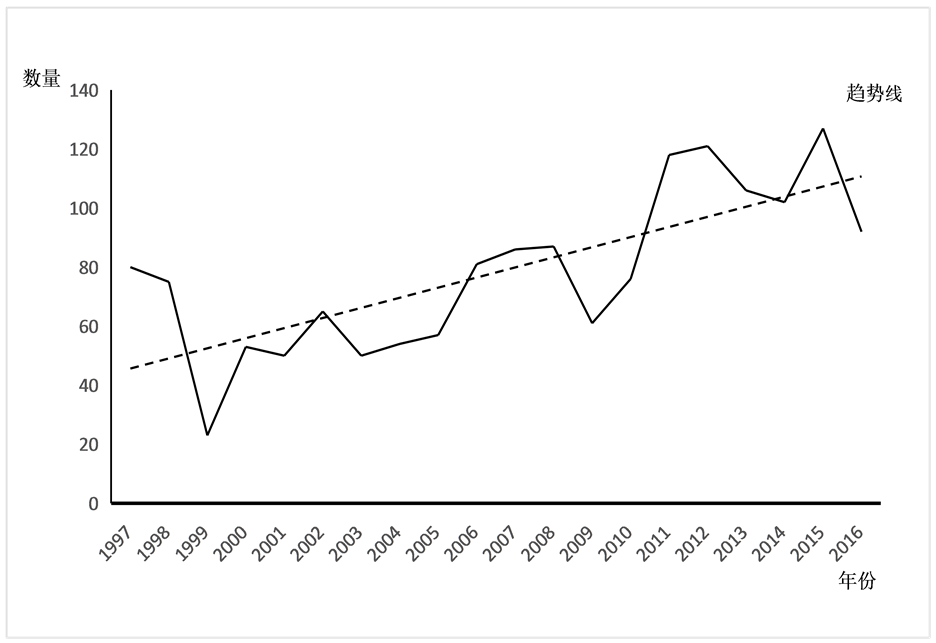1. 引言
遗产作为旅游资源,具有鲜明的独特性、多样性、不可移动性、吸引力的定向性和不可复制性,由此成为旅游开发的重要资源之一。遗产旅游甚至在古代就已经存在,并且是最古老的旅游形式,很久以前,人类就学会了将古代和近代的遗留物作为城市和乡村的娱乐资源(Newcomb, 1979) [1] 。遗产被认为是旅游业中一个重要的而且增长最快的组成因素 [2] [3] 。而且需要用不同的方式进行管理和市场化运作 [4] 。特别是联合国教科文组织于1972年10月17日至11月21日在巴黎举行的第十七届会议中,注意到文化遗产和自然遗产越来越受到破坏的威胁,社会各界开始关注遗产的保护,而旅游为遗产带来的双重效应也开始成为学者、政府、媒体及社会公众的新的关注点,随着旅游需求的持续快速增长,关于遗产旅游的保护与开发仍然是学术界的关注点。
国外对遗产产业的研究始于20世纪中期,主要集中在20世纪末期,研究对象不局限于世界遗产地(World Heritage Site),而是涉及所有遗产旅游地 [5] 。国外关于遗产旅游的研究已经较为深入,形成多学科、多层次的局面,其研究热点包括遗产旅游的利益相关者、遗产旅游者、真实性、各类遗产旅游地、遗产旅游的管理等。陶伟等对国外遗产旅游相关研究进行了综述,评述了1974年至2003年间《Annual of Tourism Research》国外遗产旅游研究的成果 [6] ,王晓梅等人通过比较国内外具有代表性的112篇遗产旅游资源管理文献,对国内外遗产旅游资源管理研究的特点与发展趋势进行了探讨 [7] 。本文基于国内外已有的研究文献,采用文献分析法,进一步对国外遗产旅游研究的议题和焦点问题进行初步梳理。
2. 国外遗产旅游研究概况
2.1. 国外遗产旅游研究文献概况
本文以ScienceDirect数据库的文献为基础,以“heritage tourism”为关键词进行检索,对1997年至2016年在《Annals of Tourism Research》和《Tourism Management》中发表的文献的数量进行了统计(如图1),由图可知,从2009年后,国外关于遗产旅游研究的文献数量持续上升,2012年后国际上关于遗产旅游的研究数量进入了一个新高度,并在2015年达到了历年来的最高值。由此,我们可以得知遗产旅游受到学术界越来越多的关注,同时关于遗产旅游的研究成果也逐渐增多。
2.2. 本文的研究文献选择
本文选取了近5年来,在《Annals of Tourism Research》和《Tourism Management》中发表的548篇

Figure 1. Number of heritage tourism studies from 1997 to 2016
图1. 1997年至2016年遗产旅游研究文献数量
与遗产旅游相关文章,从中筛选了相关度较高的49篇文章进行分类与整理,其中2016年4篇,2015年21篇,2014年6篇,2013年11篇,2012年7篇。
通过对所筛选的49篇文章的分类与整理可知,国外遗产旅游文献主要是关于遗产旅游管理、利益相关者、遗产地(遗产项目)以及遗产旅游者四个方面的研究,分别有占34%、26%、24%以及12% (如图2)。除此之外,国外研究文献中还涉及到遗产旅游资源在数字时代的开发方式以及从不同学科角度对遗产旅游进行的研究 [8] [9] 。
近年来,我国学者对国外遗产旅游研究内容的划分有:王晓梅等将其分为遗产社区,政府角色、政策,游客体验,可持续发展,遗产真实性,UNESCO世界遗产提名、遗产保护准则 [7] ;陶伟等从文献性质的角度出发,将关于遗产旅游的研究论文的议题分为对世界遗产项目的研究和对“广义”遗产的研究,其中对“广义”遗产的研究涉及到12个方面,包括遗产旅游的定义,遗产旅游在开发中的保护,遗产旅游的管理,旅游者的需求与动机、行为和体验,遗产旅游的影响,真实性,遗产旅游解说,遗产旅游中的利益分析,遗产旅游与消费,遗产和后现代旅游的关系,遗产旅游的价值,遗产作为旅游资源的开发利用 [6] ;张朝枝和保继刚将国外研究文献的主要内容分为遗产地研究、遗产旅游者研究、遗产地的社区、政府/组织、媒体等利益相关者研究以及遗产地旅游活动的管理等几个方面等 [10] 。
本文主要从以下两个方面对国外遗产旅游研究进展进行梳理,以期为我国遗产旅游的发展与研究做参考。首先,明确遗产和遗产旅游的内涵和外延,有助于我们对遗产旅游有科学的认识,进而为遗产旅游的研究奠定坚实的理论基础;其次,对国外遗产旅游的研究内容进行梳理和分析,进而了解国外关于遗产旅游研究的新进展。

Figure 2. Distribution of heritage tourism research
图2. 遗产旅游研究内容分布
3. 遗产与遗产旅游概念的界定
3.1. 遗产的起源和内涵
20世纪70年代,“遗产(heritage)”一词产生于欧洲(Richard prentice, 1993),其涵义通常指从祖先继承下来的东西。作为继承物,遗产代表一个特定民族及其价值观,规范和信仰的基本特征 [11] 。由遗产的涵义我们可以得知遗产具有历史性、独特性、文化性的特征,而其独特性是遗产作为旅游资源被开发的重要特性。
随着社会经济的不断发展特别是交通运输业的进步,促使不同文化之间的交流愈加便捷,于是遗产被越来越多的用于商业用途,其含义也在不断丰富,地方人文、历史人物、历史事件发生地都被认作是一种遗产。1980年晚期,一些民间艺术、民族建筑风格就被认为是遗产,遗产进入了大众化时期 [10] 。在我国的《旅游资源的分类、调查与评定》中,民间演艺、传统与乡土建筑等遗产被化分为可以用以吸引游客旅游资源。由此可见,遗产的内涵虽然在不断丰富,但它仍然离不开其历史性和独特性的特征。
3.2. 遗产旅游
遗产旅游活动很早就已经产生,一般认为1975年欧洲的“建筑遗产年”是遗产旅游成为大众消费需求的标志,介绍城市历史的“遗产中心(heritage centre)”在这一年大量出现,遗产保护受到越来越多的关注。世界旅游组织(UNWTO)将“遗产旅游”定义为“深度接触其他国家或地区自然景观、人类遗产、艺术、哲学以及习俗等方面的旅游”。关于遗产旅游的概念,国外学者还未统一,英国学者戴伦·J·蒂莫西、斯蒂芬·博伊德在《遗产旅游》一书罗列并分析了一些关于遗产旅游的定义,分别从旅游者动机、旅游供给、旅游目的地等角度对遗产旅游进行了界定。还有学者提出,遗产旅游是关注我们所继承的、一切能够反映这种继承的物质与现象——从历史建筑到艺术工艺、优美的风景等的一种旅游活动 [12] 。Poria等认为,遗产旅游是旅游的一个子群,这个子群指的是旅游者去某个地点旅游的主要动机是建立在旅游者将该旅游地当作是自己遗产的基础之上 [13] 。刘庆余认为遗产旅游是指将遗产资源作为吸引游客的吸引物,吸引人们到遗产所在地区去欣赏遗产资源,体验遗产文化氛围,从而获取一种特定的旅游体验 [14] 。
遗产的概念不是由旅游的发展而产生的,自遗产概念出现之日起就被冠以保护的招牌,旅游改变不了产生于比旅游系统还大、还要重要的社会所决定的遗产概念的初衷。由此便产生关于遗产与旅游的关系的争论,大部分争论认为“旅游”与“遗产”是可以共存并且可以相互促进的,提出了“保护与开发相协调”、“旅游促进遗产保护”等口号。虽然从遗产旅游的字面上看,遗产旅游是旅游的一种形式,但不论从什么角度对遗产旅游下定义,都不能离开对于遗产的保护及促进遗产的可持续发展的初衷。
综上所述,遗产旅游的定义首先应该符合旅游的定义,因为遗产旅游本质上是一种以遗产地为旅游目的地的游客的出游行为。其次,由于游客的出游目的有多样性的特征,所以构成遗产旅游行为发生的必要条件应该包括游客的动机,即遗产地是构成游客出游动机的一个重要因素之一。最后,由于遗产本身具有受保护的特性,而遗产作为旅游目的地被开发的一个重要目的是维持遗产地的可持续发展,所以在对遗产旅游下定义时,其内涵必须包括遗产旅游是有利于或者能够促进对遗产的保护工作的开展。
自20世纪年70年代以来,作为新旅游(new tourism)或替代旅游(alternative tourism)的主要形式之一,遗产旅游在世界范围内得到了长足发展 [15] ,遗产已成为目前超过40%的国际旅行中的核心要素 [16] 。遗产作为新的旅游吸引物日益受到关注,与此同时国内外学者对遗产旅游的研究也呈现出多角度、多学科交叉的趋势,诸如社区参与、利益相关者、真实性、遗产旅游的管理等,成为遗产旅游研究的重要内容。
4. 国外遗产旅游研究的主要内容
4.1. 遗产旅游管理的研究
对于遗产旅游的管理,我们首先要明确的是遗产旅游的发展是以保护为前提的,旅游活动与遗产的保护是相互协调的。学者Stephen J. Calver和Stephen J. Page的研究提出,应当让遗产旅游的管理者意识到娱乐活动与优先保护之间不排斥而是互补的,可以通过协调游客的参与活动,打造属于他们自己的经历 [17] 。
近年来,如何能让遗产项目成为吸引和留住游客的原因成为国外遗产旅游研究的热点,研究中提出了让游客了解遗产的真实性、游客参与、提供服务等方法。了解遗产的真实性对旅游管理和市场营销非常重要,因为对遗产地的介绍直接影响到游客访问遗产旅游地的动机 [18] ,通过积极鼓励游客参与到文物保护中可以满足游客的娱乐和消遣的参观目的 [17] 。许多学者通过建立模型来研究游客的参与程度、游客对遗产地真实性的了解等对其旅游动机的影响 [18] [19] [20] 。
4.2. 遗产地的研究
对于遗产旅游地的描述主要是关于遗产地的开发与规划、遗产的价值。目的地管理者们越来越热衷于将遗产资产作为鼓励旅游活动的平台。特别是在遗产可以看作是其“持续竞争优势”的地区。以澳大利亚的一个中国文化区为例,通过采访利益相关者的方法,得出并不是所有遗产都能够为游客提供完美的经历(peak experience),反而为此而进行的商品化可能既不合理也不会被利益相关者接受,遗产地吸引游客的方法是将peak experience和supporting experience相结合 [21] 。
Su Yu-Wen等的研究表明,由于一国世界遗产地数量的增加对于入境游客有非常积极的影响,所以申请世界遗产属于双赢的措施,不仅是为了保护一国已有的文化和自然资源,还为了促进其旅游业的发展。由此我们可以得知旅游业的发展与遗产的保护并不冲突,正是由于保护措施在保证遗产可持续发展的同时保证了旅游业的可持续发展 [22] 。
虽然许多研究表明学习和继承是遗产旅游的主要动机(Gonzalo, 2011, Kerstetter et al., 2001, Sun and Shi, 2012) [23] [24] 。但Lee Yi-Ju的研究表明,学习与怀旧并不能维持遗产旅游者与遗产地之间关系,烹饪吸引物被认为是最重要的遗产怀旧,其次是个人的情感和文化遗产 [25] 。另外,Emily针对工业遗产旅游提出了通过设立游览主题、游览项目以及精心设计等措施以提高工业遗产地的吸引力,同时还依赖于当地居民的认可和遗产所有者 [26] 。可见,今后对于遗产旅游地的开发是以游客需求为导向的多样性的开发。
4.3. 遗产旅游的利益相关者的研究
“利益主体”是一个来自于管理学的概念,最早出现在20世纪60年代,确立于20世纪80年代 [27] 。Freeman [28] 提出了利益主体的概念,指任何被共同目标的完成所影响,或者能影响共同目标实现的个体或可辨别的群体。国外大多是以旅游经营者为核心分析旅游利益主体,他们的市场战略和经营策略一定程度上决定了遗产地的可持续发展 [29] 。Sautter和Leisen [30] 根据Freeman的利益主体示意图给出了以旅游规划者为中心的利益主体图示,如图3。
利益相关者的责任以及他们之间的相互关系是国外遗产旅游管理研究的主要领域,主要探讨的有在遗产保护及管理方面主要利益群体的职责、不同利益群体之间的相互关系以及他们在遗产管理中所用的方法,为实践中如何协调遗产旅游利益相关者的关系以及管理方法的应用提供了理论依据。遗产地开发与保护的主要利益相关者遗产旅游经营者、政府部门、旅游者及社区居民。
4.3.1. 经营者
遗产作为一种受保护的公共性资源,其开发和保护受到多方关注,各国都在为寻求遗产旅游开发的利益平衡点而努力。企业经常是遗产地旅游的开发者或投资者,由此企业在遗产旅游开发和经营中的责任成为各国学者的研究重点。虽然早期的一些调查表明,企业在遗产地建设的人造景点很难被当地居民和游客认同为遗产的一部分,同时一些曾被当地居民认同的遗产也很难被企业行为改变他们的认识 [31] ,但近年来的研究表明,企业对于遗产的修复及开发有积极的意义,同时对遗产地社区的发展有显著的促进作用 [32] 。这些问题往往与企业在遗产旅游经营中的目的和责任密切相关。英国学者Victoria K. Wells 等人的研究发现,不论是学者还是接受调查的人,他们的观点都表明就企业社会责任文化背后的理论基础而言,旅游组织与其他商业组织是不同的 [33] 。相关研究文献的观点表明,旅游组织的经营目的已经从经济利益动机走向可持续性(Jamrozy, 2007)和旅游业可持续发展的代际/继承方面 [34] 。

Figure 3. Schematic diagram of the interests of the tourism industry
图3. 旅游业利益主体示意图
旅游业既有娱乐性也有不同程度的教育意义 [35] ,所以遗产旅游的教育作用对企业社会责任的发展方向有重要的指导性。企业作为遗产旅游的重要开发者开始逐渐意识到遗产旅游可持续发展的重要意义,其经营目的也由最初的以经济利益为主转向兼顾社会利益。企业在遗产旅游开发中观念的转变有利于其提升在社会公众中的形象,为其在遗产旅游业中的长久发展奠定了坚实的基础。
4.3.2. 政府部门
管理者必须平衡不同的价值观、优先权和利益,在不同参与者之间做出调和,提出一个基于价值观的,多元的管理方式,解决管理的冲突,在不同的参与者之间达到一致的结果 [36] 。政府在旅游开发与发展中起着重要的作用。政府是遗产的规划、管理、营销者 [37] 。政府的相关政策和行为是遗产旅游资源合理保护开发、利益相关者协调参与的保证。特别是在中国这种特殊的政治经济结构下,政府在遗产旅游中发挥的作用特别显著。从政治经济学的角度考虑,国家的干预措施在遗产保护和旅游经济发展的优先性上具有重要意义。具有权力经济优势的政府显然会关注遗产的保护问题,但是同时他们还会考虑促进旅游相关经济的发展,他们经常会洞察到遗产与旅游质监的相互利益关系 [38] 。Nancy等分析了中国的中观层次的政府在旅游中自上而下所扮演的角色,认为政府在旅游业中扮演了计划者和设计者、资源的组织和提供者和控制者 [39] 。国家的干预措施是遗产保护和旅游业经济发展中有相对优先性的重要部分,在城市政府中强大的“政策共同体”的成员显然是关注遗产保护,但他们也积极地关注促进与旅游相关的经济发展 [38] 。
4.3.3. 遗产旅游者的研究
针对遗产旅游者的研究主要有游客的动机、游客感知、游客参与等方面。
游客满意是旅游者体验的一种评价,在旅游文献中得到了广泛的研究 [40] 。旅游者体验与游客满意度是正相关的关系,感知的真实性和游客的体验对目的地形象的形成有一定贡献,目的地形象在感知的真实性和游客满意度之间起中介作用,在游客体验和游客满意度之间起一定的中介作用 [41] 。
Francesco Massara等将心理距离的概念引入遗产旅游的游客体验研究,认为低心理距离将营造更具体和情境化的概念,高心理距离将造成宏观的、抽象的对遗产客体的内部感知 [42] 。外部因素中,Yaniv Poria等的研究甚至发现命名为世界遗产地也对游客对遗产概念的理解和体验有一定的影响 [43] 。Gyan P.等将社会距离的概念引入到遗产旅游者的动机研究中,提出虽然种族、国籍经常被当作形成社会距离的决定性因素,但是职业,政治思想和宗教也是影响社会距离关系的重要变量 [44] 。
4.3.4. 社区居民
旅游业的成功需要社区居民的支持,特别是在一些发达国家,个别遗产的所有权是属于当地居民的,由于居民对旅游业所持的态度的不同,使得个别地区遗产旅游的发展并不顺利。通常持支持态度的居民希望通过旅游业以改善他们的生活,持反对意见的居民会阻碍旅游业的规划与开发。许多研究表明,当地居民的能力不足以对旅游业的发展产生积极的促进作用,但英国学者Kathy等人的研究肯定了当地居民在促进旅游业发展中的作用,他们认为当居民有了所有者的意识后并授权他们参与到旅游业的建造过程中时,他们有巨大的共同建造潜力 [45] 。Spencer等以美国一处在被联邦政府关闭之后由当地居民自发运营的景点为例,对社区支持为遗产旅游带来的经济效益做了研究,结果表明,社区支持为遗产旅游的发展带来了巨大的效益,包括增加了景区的营业收入、居民个人收、当地税费收入和新工作 [46] 。
5. 结论与启示
5.1. 初步结论
遗产旅游的研究是一个渐进的过程,目前国外关于遗产旅游的研究已经发展到了多学科融合、多种研究方法应用、研究主题丰富化的阶段,尽管到目前为止国外旅游学界尚未形成关于遗产旅游的统一概念,但随着学者们研究的深入以及扩展,关于遗产旅游的概念一定会形成一个统一的系统化的体系。就现有的研究文献来看,学者们努力从各个角度分析遗产旅游的含义 [12] [13] ,在研究过程中关于遗产旅游的概念基本上形成了多角度分析的认知。
综合来看国外近5年关于遗产旅游的研究,其定性研究与定量研究的结合,保证了研究结果的科学性,对于我国遗产旅游的研究具有很大的参考价值。但同时也存在一定的问题。就研究成果来看,由于多数研究采用的是单一案例,形成的结论略有偏颇,未来关于遗产旅游的研究需要形成区域性或全球性观念;就遗产研究类别而言,国外的研究偏于人文类遗产,关于自然类的遗产的研究较少。
5.2. 启示
对我国遗产旅游研究的启示主要有:
研究方法上,注重定量研究与定性研究的结合,特别要注重定量研究的使用,以增强研究的科学性。
研究内容上,一方面要重视个案研究,国外的研究多数属于个案研究,由此可见遗产旅游研究的发展需要先从个体遗产的研究出发,进而进行总结与归纳,得出具有普遍性的结论,另一方面,在个案研究的基础上形成遗产旅游研究的区域性视角,在个案研究的过程中注重定量方法的使用。
另外,在遗产旅游的研究中,首先,应该形成正确的关于遗产开发与旅游之间的关系的看法,即二者并不是相互矛盾的。在我国,由于特殊的历史和政治原因,所以在遗产的所有权方面有着与国外不同的情况,所以在研究我国遗产旅游的过程中,对政府和企业的研究是必不可少的,通过研究明确他们的责任与义务,以期为我国遗产旅游的可持续发展提供帮助。同时,特别要重视我国遗产的保护问题,加强关于遗产保护与管理的问题的研究。当然,遗产所在地居民在遗产旅游的发展中也发挥着不容小觑的作用,所以也应加强关于遗产地居民与遗产旅游的发展之间的关系的研究。在发挥居民在保护遗产中的作用时,可以考虑参考国外充分授权居民权利的方法。
基金项目
国家自然科学基金面上项目“区域旅游产业可持续发展管理创新研究”(71373174)。